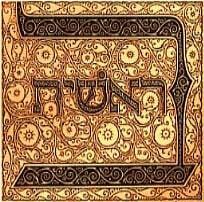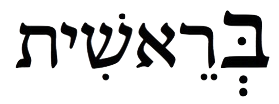Dedicated to the memory of Professor Yaakob David Bekenstein
The Torah opens with the word “Bereshit” – in the Beginning – whose first letter, Bet, is written large to signify that it contains a hidden meaning. The gematriah (numerical value) of the letter Bet is 2. It has three sides – top (“roof”), bottom (“floor”) and the right “wall”:
Letter Bet of Bereshit may be viewed as the “event horizon” of the Torah.
In General Relativity, the event horizon is the area of spacetime beyond which information is inaccessible to an outside observer. For example, the event horizon of a black hole is the boundary surrounding every black hole that acts as information firewall – the light from within the event horizon cannot escape outside and, therefore, information is invisible to an observer outside the event horizon. The Chazal (Jewish sages) teach that we may not ask what was before Bereshit. The very shape of the first letter in Torah – Bet – is closed on the right and open on the left indicating that we study Torah reading left of this letter (Hebrew is written and read right-to-left), but cannot go right, i.e., we cannot obtain any information on what was before Bereshit – before the Beginning of the Creation. Thus, the first letter of the Torah – letter Bet – represents, as it were, the “event horizon” of the Torah.
 In 1972, Jacob Bekenstein, at the time a doctoral student in Princeton, proposed that black holes have maximum entropy (the measure of disorder related to information) and showed that black hole’s entropy is proportionate to the surface of the event horizon. Stephen Hawking first opposed this idea but later embraced it. However, Hawking realized that, if this was true, the information would vanish forever in black holes violating information conservation law – a cornerstone of quantum mechanics. He called it “Black Hole Information Paradox.”
In 1972, Jacob Bekenstein, at the time a doctoral student in Princeton, proposed that black holes have maximum entropy (the measure of disorder related to information) and showed that black hole’s entropy is proportionate to the surface of the event horizon. Stephen Hawking first opposed this idea but later embraced it. However, Hawking realized that, if this was true, the information would vanish forever in black holes violating information conservation law – a cornerstone of quantum mechanics. He called it “Black Hole Information Paradox.”
I first met Jacob Bekenstein in 2005, at the International Conference on General Relativity and Gravitation in Dublin, where each of us presented our research on General Relativity. We were the only two physicists wearing kippah (skullcap). In fact, we met during a lunch break while waiting for our kosher food to be delivered. We discussed physics while eating our kosher sandwiches. At that time, Dr. Bekenstein was a professor of theoretical physics at the Hebrew University in Jerusalem. He invited me to come there to give a lecture on my research. To this day I regret that I did not take him up on his invitation. Sadly, Prof. Bekenstein suddenly passed away this (2015) August at the age of 68. He was a great theoretical physicist and a Torah observant Jew. This post is dedicated to his memory.
Steven Hawking was also at that conference. His keynote lecture was devoted to the Black Hole Information Paradox. More than forty years of research by Hawking and other leading theoretical physicists still did not lead to a resolution of the Information Paradox.
That same year, 2005, Leonard Susskind, a professor of physics at the Stanford University in California, visited his friend, Gerard ’t Hooft of the Ultrecht University in Holland, who received in 1999 Nobel Prize in Physics for his contribution to the development of the Standard Model (the leading theory of particle physics). ’t Hooft and Susskind developed the Holographic Principle, according to which the information contained in any three-dimensional volume of space can be encoded on the two-dimensional boundary of that space. This is a direct consequence of the seminal discovery by Bekenstein that the information contained in the black hole is proportionate to the surface of its event horizon.
We are all familiar with holograms that grace our credit cards. Holograms are three-dimensional images that are encoded on a two-dimensional film. A hologram is not a photograph of an object – it’s an image of the interference pattern generated by a coherent light shown on that object. This information is scrambled on the hologram – if you look at it under a microscope, you will see just a bunch of black dots. This information must be unscrambled to reconstruct the three-dimensional image.
Susskind expanded the Holographic Principle from a black hole to the entire universe, which, according to the Holographic Principle, is a hologram of the information encoded at its two-dimensional boundary. This completely counter-intuitive and mind-bending concept was, at first, met with great suspicion and skepticism by the majority of physicists. Today, it is a part of mainstay physics and is widely used in string theory, quantum gravity and other areas of theoretical physics.
What I recently realized is that the Holographic Principle provides a perfect example for an obscure concept in Kabbalah – the Primordial Man – Adam Kadmon.
Adam Kadmon (abbreviated as the A”K) is the first partzuf (a sefirotic configuration, visage), although the sefirot in the A”K exist only in their latent state. A”K has no kelim-vessels – only Divine light. The A”K precedes the four worlds of Atzilut, Beriah, Yetzirah, and Assiyah. A”K is the first stage of the creative process immediately after the Tzimzum (the primordial contraction of Divine light Ein Sof). This concept is discussed at length by Rabbi Chaim Vital in the Etz Chaim (Drush “Agulim v’Yosher”) and in the Hemshech Samach Vav by the Rebbe Reshab (the fifth Lubavitcher Rebbe – Rabbi Sholom Dovber Schneersohn). The essential characteristic of the A”K is that it contains the entirety of information about every spiritual and physical object and being in the Universe. Moreover, it contains the information of the past, present, and future of every object and being, where all events exist “at the same time,” as it were, because the A”K precedes the creation of time, which, according to Kabbalah, takes place in the world of Atzilut. The entire universe may be seen as the hologram of the information “encoded” in the Adam Kadmon. This is why the Holographic Universe is the perfect metaphor for Adam Kadmon.
All this is hinted in the first letter of the Torah – the letter Bet. As mentioned above, it has three parts but its numerical value (gematria) is 2, hinting at the Holographic Principle, according to which the three-dimensional world is a hologram encoded on its two-dimensional boundary. Perhaps this is why it is written larger than other letters as if enveloping them. Perhaps also this is why the Chazal identifies Bet of Bereshit as the boundary – the event horizon of the Torah.




Leave A Comment